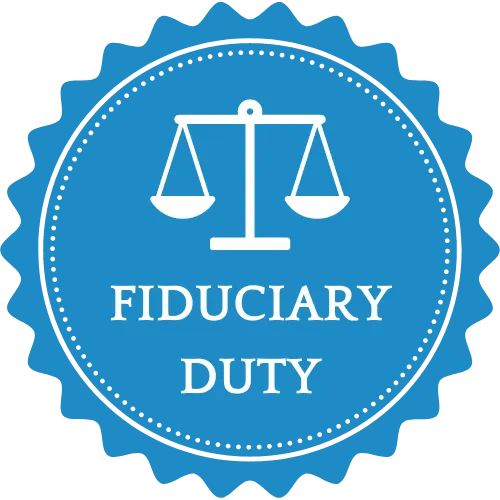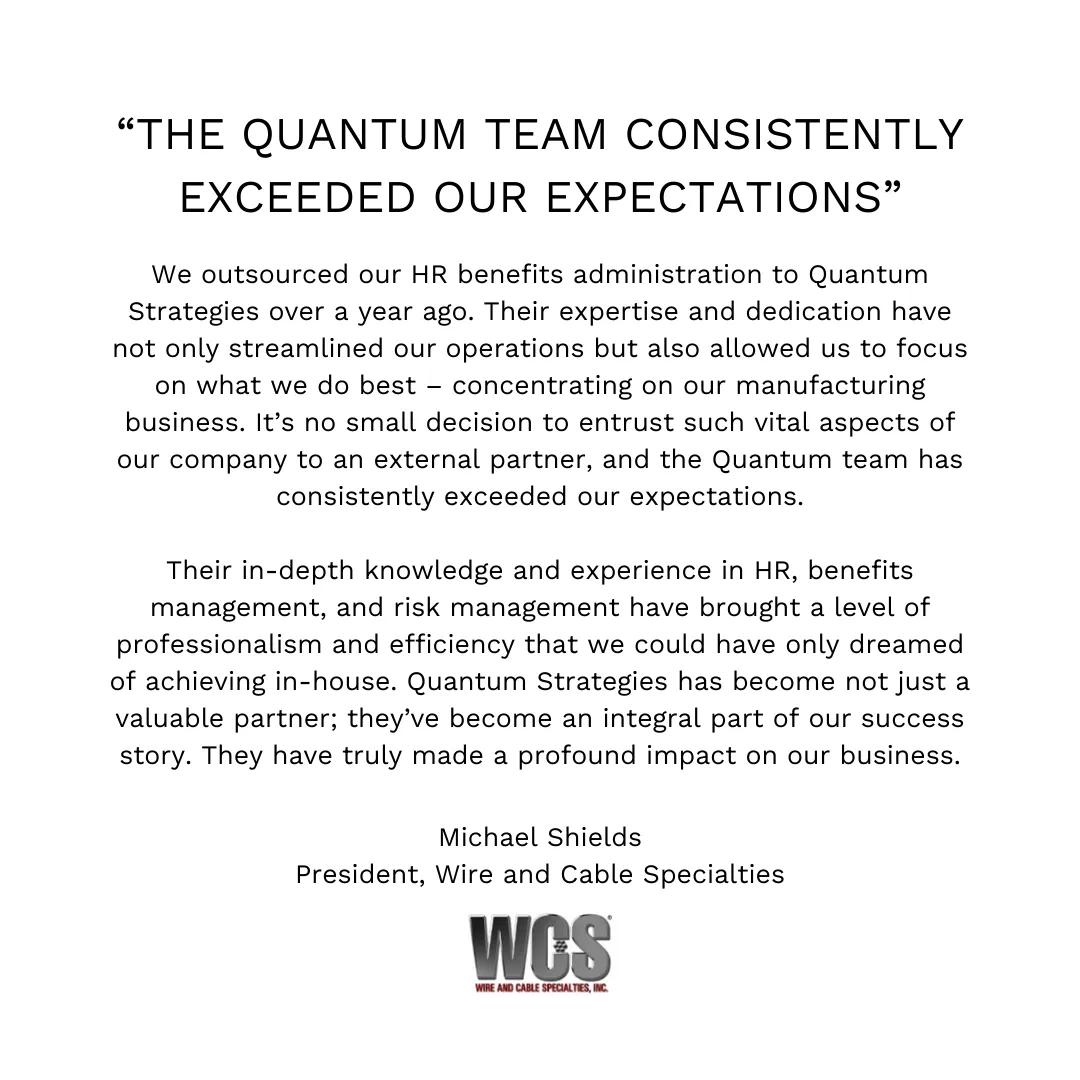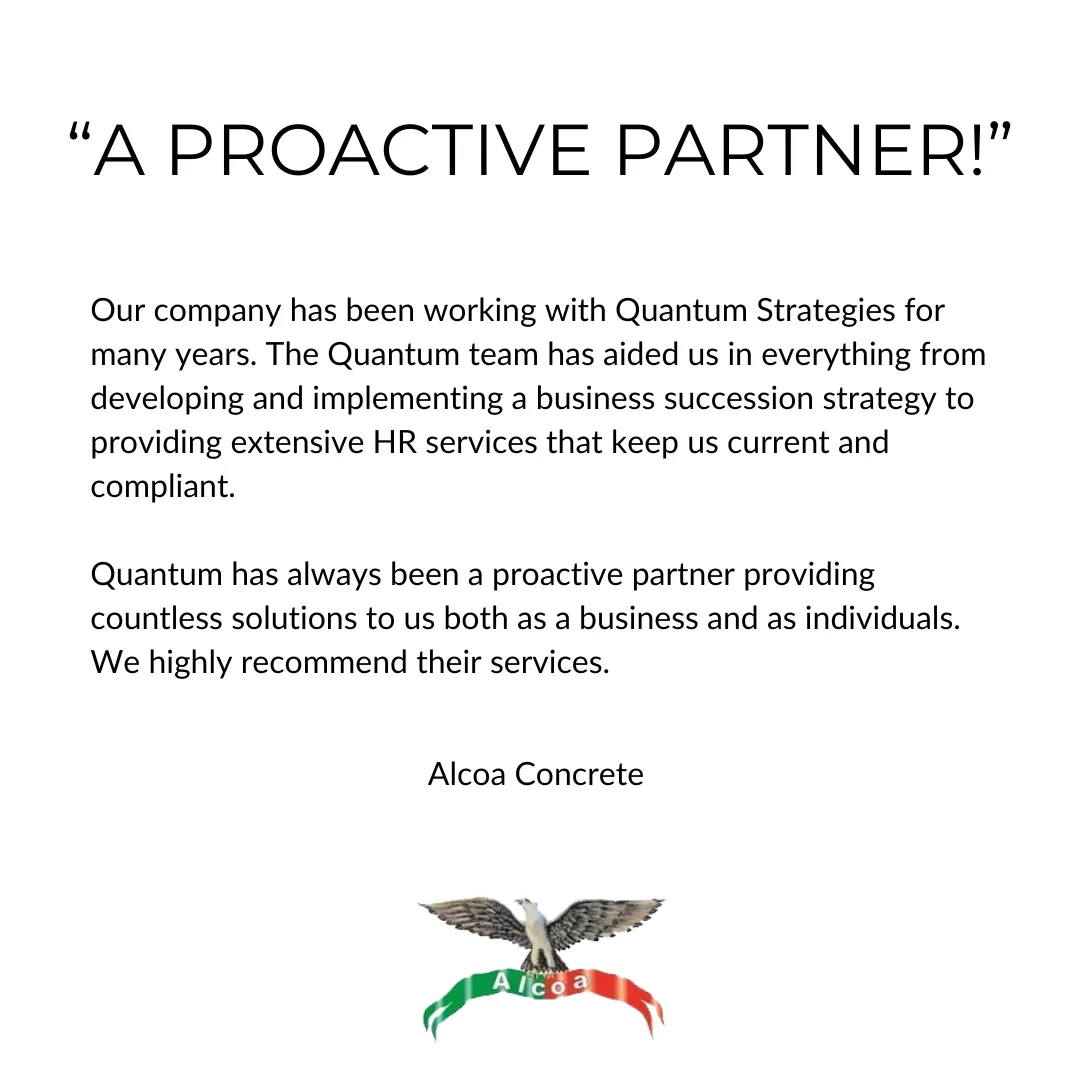Tailored HR Solutions as Unique as Your Business
Expert consulting and service to elevate your HR from a headache to a value driver.
Does Your HR Function Make the Grade?
Take our 5-minute quiz and evaluate the effectiveness of your HR function.

How We Help
We Focus on Your HR Needs,
So You Can Focus on Your Mission.
At Quantum Strategies, we understand that effective human resource management is the cornerstone of every successful business, regardless of size. Our mission is to provide tailored HR solutions that align perfectly with your unique business needs and growth stage.
Our Services
Navigating Change with Confidence: Quantum Expert HR Solutions
From Policy Assistance to Leadership Succession Planning, Quantum Strategies is Your Ultimate HR Resource to Solve Your Business Challenges.
HR Operational
Assessments
Unlock the full potential of your HR department. Our collaborative approach brings clarity and efficiency to your HR operations, providing a thorough analysis of your department's structure, costs, effectiveness, and needs.
Comprehensive Analysis: Detailed evaluation of your organization, workgroups, and individual roles for optimized efficiency.
Objective Insights: Receive a clear blueprint highlighting your HR department's strengths, weaknesses, and gaps.
Strategic Recommendations: Actionable plans focusing on technology utilization, communication enhancement, and leveraging department strengths.
HR Consulting and Managed Services
Tailored to align with your unique needs, our HR consulting and managed services enhance operational efficiency and effectiveness, allowing you to focus on your core mission while we optimize your HR investment.
Expert Supplemental Support: Strengthen your existing HR team with specialized expertise to navigate complex HR landscapes.
Personalized, Agile Solutions: Customized services for organizations with or without HR teams, adaptable to your specific requirements.
Goal-Oriented, Clear Communication: Delivering precise, actionable strategies that align with your organization’s goals and ensure successful execution.
Custom HRIS Design and Integration
Revolutionize your HR data management. Our team will evaluate your current human resources technology stack, offer recommendations, and then integrate your new and existing systems with our cutting-edge technology, ensuring seamless data flow and optimized operational efficiency.
Seamless Integration: Connect legacy systems with modern platforms for streamlined data management.
Tailored Design: Custom HRIS solutions uniquely crafted to meet your specific business needs.
Advanced Analytics: Leverage data-driven insights for strategic decision-making and operational excellence.
“Successfully steering through the specialized HR challenges within organizations of all kinds demands expert understanding, strategic planning, and precise implementation. With comprehensive knowledge of these challenges and the right solutions, your business can stay focused and successful in their vital missions.”
William J. Rizzo

Who we Are.
We Focus on Your HR Needs,
So You Can Focus on Your Mission.
At Quantum Strategies, we recognize that proficient management of human resources is fundamental to the success of any enterprise, irrespective of its scale. Our objective is to deliver customized human resource solutions that are in perfect harmony with your distinct business requirements and developmental phase.
Constant Improvement
Commitment to Customers
High Level Of Knowledge
Best Service You Can Get



Why Choose Us
A True Partner to Solve Your Most Complex HR Challenges.
Empowering HR Innovation and Compliance
Commitment to 100% Client Satisfaction
People-First Approach

Peace of Mind:
Handle ongoing compliance with ease

Employee Satisfaction:
Build a positive workplace with engaged employees

Strategic Confidence:
Drive strategy with advanced analytics

Leadership Development:
Equip your team with the tools to lead

2,245 +
Happy Clients

25 +
Years Of Experience

120 +
Professional Team
Testimonials
The Quantum Commitment - 100% CLIENT SATISFACTION!
At Quantum, we understand that your satisfaction matters most, and The Quantum Commitment is our way of putting that understanding into action. Experience the difference with a team that is dedicated to making your satisfaction the cornerstone of our service. Because when you choose Quantum, you choose excellence, reliability, and a commitment to exceeding your expectations every time.
Our Resources
Unveiling Proven Strategies and Insights.
Discover actionable tips, expert advice, and industry insights to fuel your journey towards success.

Fostering a Psychologically Safe Workspace
As we navigate the complexities of the post-pandemic world, the importance of mental health in the workplace has surged to unprecedented levels. According to research from the
American Psychological Association, 81% of employees are now actively seeking workplaces prioritizing mental well-being.
Key Challenges Faced by Human Resources in Nonprofit Organizations
The nonprofit sector brings its own set of specialized difficulties, especially in the area of human resources (HR). Although these difficulties may share some common ground with those in the for-profit industry, they possess unique characteristics that require special attention from nonprofit leaders.
FOUND THESE HELPFUL?
Explore Additional Articles and Resources In Our Blog

Strategic Alignment in HR: A Guide for Modern People Leaders
Strategic alignment in HR means making sure your people strategy directly supports your business goals. In this guide, we’ll walk through how HR leaders can build strategic alignment in HR step by step, so your talent, culture, and processes actually move the company forward.
HR heads are increasingly regarded in today’s corporate context not only as administrators or policy enforcers. Instead, they are seen as key strategic allies helping shape culture, guide leadership, and directly impact corporate results. The need for HR to focus on high-impact areas that connect talent to broader company goals grows alongside rising expectations.
Through strategic alignment, HR is among the most effective ways it can contribute at this level. This is about ensuring that every individual, team, and procedure operates in harmony toward the same goals, rather than just using a buzzword. Strategic alignment enables businesses to move faster, maintain greater focus, and achieve better outcomes when executed effectively.
This manual explains what actual strategic alignment is, why it is crucial for long-term success, and what measures human resources specialists can take to achieve alignment among people, procedures, and purpose. These ideas can guide you in leading with effect, whether you are constructing alignment from the ground up or enhancing what is already in place.

What Is Strategic Alignment?
Strategic alignment ensures that every department, team, and employee throughout the company is aligned with the company's overall objectives. It's about establishing a clear line of sight between day-to-day activities and long-term strategies, such that events on the ground help what leadership is attempting.
Regarding HR, this entails coordinating all people-related activities—including recruitment, onboarding, performance evaluations, training, and leadership development—with the firm's mission and business goals. Every project should aid the larger view, that is, revising job descriptions or introducing a new learning tool.
When strategic alignment is strong:
● Employees understand the company's mission
Clear communication and purpose-driven work boost engagement and motivation.
● Resources are used effectively.
Time, money, and talent are directed toward the initiatives that matter most, reducing waste and confusion.
● Goals at every level reinforce one another.
From individual contributors to executive leadership, objectives are interlinked and drive progress in the same direction.
● Decision-making is faster and more consistent.
When everyone shares a common understanding of priorities, it's easier to make aligned choices without second-guessing or unnecessary red tape.
Poor alignment, on the other hand, produces uncertainty and isolation. Unaware of how their efforts fit into the larger plan, teams may function separately. Incompatible objectives can lead to departmental strain; staff members may feel aimless or underappreciated. Eventually, this kind of misalignment can destroy performance, morale, and productivity.
HR, therefore, serves a vital purpose in stopping misalignment before it begins. HR leaders help to create clarity, coherence, and consistency in the office by serving as a link between leadership vision and employee implementation.
Why Strategic Alignment Matters for HR
HR leaders today are in a unique position—they have an impact on both company results and people. HR, situated at the intersection of talent, culture, and organizational structure, can shape the execution of strategy throughout the company. HR becomes a force multiplier rather than just a support function when it guarantees strategic alignment.
Here's why strategic alignment is essential to HR's impact and effectiveness:
Improved Performance
When employees understand how their roles contribute to business goals, they're more focused and motivated. They prioritize better and spend less time on unimportant work.
Stronger Culture
Alignment helps shape a culture of clarity, purpose, and accountability. Values aren't just posted; they're practiced through aligned behaviors and decisions.
Better Decision-Making
Aligned teams don't need constant top-down direction. With shared understanding, decisions happen faster and closer to the action.
Increased Retention
People are more likely to stay when they feel their work is meaningful and connected to a larger purpose. Strategic alignment boosts that sense of impact.
Common Misalignment Issues
Even high-performing organizations struggle with misalignment. Here are some warning signs:
● Teams working on conflicting goals
● Managers are unsure how to measure success.
● HR initiatives are disconnected from business strategy.
● Employees are unclear about the company vision or values.
● Frequent changes in direction without explanation
These issues create frustration, inefficiencies, and lower morale. That's why intentional alignment must be a top priority, not just during annual planning, but throughout the year.

How HR Can Drive Strategic Alignment
Strategic alignment is created through deliberate effort over the entire employee life cycle, rather than by coincidence. By linking people, performance, and purpose throughout the company, HR leaders are uniquely positioned to spearhead this effort.
This is commonly ignored in many HR departments today. A recent Deloitte study found that 72% of respondents recognize the importance of HR cross functionality, while only 41% are taking action, and only 11% are taking action in a meaningful way.
1. Understand the Business Strategy
Before HR can align people with the mission, it must first understand that mission in detail. This means going beyond surface-level goals and gaining a proper grasp of:
● Business priorities and growth objectives
● Market trends and competitive dynamics
● Operational challenges and success metrics
● Customer expectations and revenue drivers
To do this well, HR needs a seat at the table. Meet regularly with senior leaders. Participate in planning discussions. Ask thoughtful questions—and speak the language of business. When HR understands the strategy, it can shape policies and programs that directly support it.
2. Align Talent Strategy to Business Goals
Your workforce is your strategy in action. Every HR decision—from who you hire to how you develop and retain them—should be in service of key business objectives.
● Recruitment: Focus on roles and skills that are mission-critical
● Training & Development: Prioritize learning programs that close current gaps and build future capability
● Succession Planning: Identify and prepare future leaders who can carry strategic initiatives forward
3. Cascade Goals Throughout the Organization
When strategy rests at the top, alignment fails. At every level of the firm, HR can help leaders convert broad goals into specific, quantifiable targets.
To ensure consistency and clarity, utilize organized goal-setting techniques such as OKRs or SMART goals. Empower managers to set meaningful goals with their teams, linking daily efforts to broader business outcomes.
Everybody works smarter, not harder, when they understand why they are working and what they hope to achieve.
4. Reinforce Alignment Through Communication
Strategy is only as strong as the communication that supports it. HR plays a crucial role in making strategic goals visible, repeatable, and relevant to employees at all levels.
Key tactics include:
● Highlighting strategic updates during town halls and team meetings
● Celebrating wins that align with key priorities
● Sharing real stories of employees living out the strategy
● Encouraging leaders to connect team efforts to company-wide goals
Frequent and transparent communication creates a shared understanding—and that's the foundation of alignment.
5. Embed Strategy into Performance Management
Performance management isn't just about individual contributions; it's about strategic impact. HR should ensure that feedback, evaluations, and recognition reflect how well employees are advancing key priorities.
That means:
● Aligning performance criteria with business goals and values
● Holding regular coaching conversations tied to strategic direction
● Rewarding not just what people do, but how they do it
● Providing growth opportunities aligned with future business needs
When performance systems are strategic, employees naturally focus their energy on the right direction.
6. Shape a Culture That Supports Strategy
Culture is more than values on a wall—it's how strategy gets executed every day. HR plays a central role in ensuring that cultural norms reinforce, rather than conflict with, business priorities.
Build alignment by:
● Hiring individuals who bring cultural depth and alignment with future needs
● Recognizing behaviors that support the HR strategy
● Promoting accountability, open feedback, and continuous learning
● Ensuring that leadership models the culture they expect to see
A strategy-aligned culture doesn't slow things down, it drives momentum.
7. Measure and Adjust Continuously
Strategic alignment doesn’t evolve with the business. HR should build feedback loops to monitor how healthy people strategies are working and be ready to adapt as needed.
Tools for monitoring include:
● Employee engagement surveys
● Goal attainment tracking
● 360-degree leadership feedback
● Retention, promotion, and mobility metrics
Misalignments are opportunities, not failures. Treat them as insight to refine direction, adjust processes, and strengthen alignment over time. Quantum strategies offers HR operational assessments to identify where your business could benefit from strategic alignment.
Strategic Alignment in a Hybrid Work Environment
Hybrid and remote work models have added complexity to the alignment process. Without daily FaceTime, it's even more important to be intentional.
Tips for hybrid environments:
● Set clear, written expectations for all roles
● Use shared digital dashboards for goal tracking.
● Host regular check-ins to maintain context.
● Invest in tools that support visibility and collaboration.
When communication is intentional and goals are well structured, alignment can be even stronger in a team hybrid setup.
HR's Role as a Strategic Partner
HR continues to evolve from a support function to a key contributor in shaping company success and driving strategic alignment. This requires a deep understanding of organizational goals, along with talent, culture, and structural transformation to advance them.
Strategic HR leaders anticipate rather than react to demand. They use data to guide decisions, design roles and teams purposefully, and ensure every stage of the employee journey aligns with the company’s direction. Strategic thinking must be embedded in recruitment, onboarding, coaching, evaluation, and rewards.
Importantly, HR also bridges leadership vision and daily operations. It helps adapt systems during strategic shifts and keeps individuals aligned throughout transitions. Whether addressing market changes, customer focus, or growth plans, HR ensures teams have the right skills, mindset, and structure.
Being a strategic partner means adding value at the leadership table—not just having a seat. That starts with viewing alignment as a continuous process, where HR fosters clarity, connection, and capability throughout the organization.
Want to turn your HR strategy into a valid business driver? Contact us we can help you design practical tools, frameworks, and development programs that connect your people to your company's vision. Let's work together to align strategy, culture, and performance at every level.
Connect
Keep Up with Our Latest News and Insights
Subscribe to Quantum Strategies' latest updates and insights.
Office: Philadelphia, PA | Glen Mills, PA | Washington, DC
Call 610.624.1770
Email: info@QS2500.com
Site: www.QS2500.com






